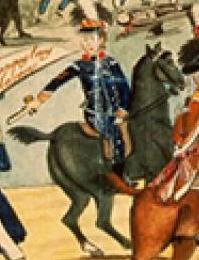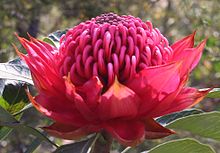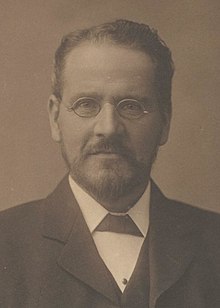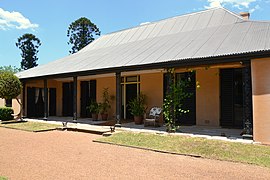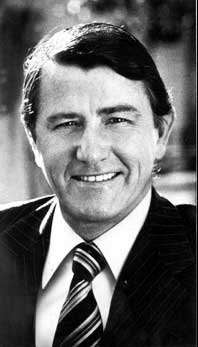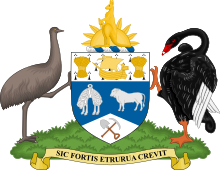Portal:New South Wales
Portal maintenance status: (June 2018)
|
The New South Wales Portal


New South Wales (commonly abbreviated as NSW) is a state on the east coast of Australia. It borders Queensland to the north, Victoria to the south, and South Australia to the west. Its coast borders the Coral and Tasman Seas to the east. The Australian Capital Territory and Jervis Bay Territory are enclaves within the state. New South Wales' state capital is Sydney, which is also Australia's most populous city. In December 2023[update], the population of New South Wales was over 8.3 million, making it Australia's most populous state. Almost two-thirds of the state's population, 5.3 million, live in the Greater Sydney area.
The Colony of New South Wales was founded as a British penal colony in 1788. It originally comprised more than half of the Australian mainland with its western boundary set at 129th meridian east in 1825. The colony then also included the island territories of Van Diemen's Land, Lord Howe Island, and Norfolk Island. During the 19th century, most of the colony's area was detached to form separate British colonies that eventually became the various states and territories of Australia. The Swan River Colony (later called the Colony of Western Australia) was never administered as part of New South Wales. (Full article...)
 Recognized content - load new batch
Recognized content - load new batch 
-
Image 1

William Alfred Brown, OAM (31 July 1912 – 16 March 2008) was an Australian cricketer who played 22 Test matches between 1934 and 1948, captaining his country in one Test. A right-handed opening batsman, his partnership with Jack Fingleton in the 1930s is regarded as one of the finest in Australian Test history. After the interruption of World War II, Brown was a member of the team dubbed "The Invincibles", who toured England in 1948 without defeat under the leadership of Don Bradman. In a match in November 1947, Brown was the unwitting victim of the first instance of "Mankading".
Raised in New South Wales, Brown initially struggled in both work and cricket, before gradually rising through the cricket ranks. He made his first-class debut for New South Wales in the 1932–33 season and forced his way into the national side during the 1934 tour of England. When long-term openers Bill Ponsford and Bill Woodfull retired at the end of the tour, Brown and his state opening partner Fingleton took over. After poor form made his selection for the 1938 tour of England controversial, Brown responded with a total of 1,854 runs, including an unbeaten 206 that saved Australia from defeat in the Second Test, and was honoured as one of the five Wisden Cricketers of the Year. (Full article...) -
Image 2
Isopogon anemonifolius, commonly known as broad-leaved drumsticks, is a shrub of the family Proteaceae that is native only to eastern New South Wales in Australia. It occurs naturally in woodland, open forest, and heathland on sandstone soils. I. anemonifolius usually ranges between one and two metres in height, and is generally smaller in exposed heathland. Its leaves are divided and narrow, though broader than those of the related Isopogon anethifolius, and have a purplish tinge during the cooler months. The yellow flowers appear during late spring or early summer and are displayed prominently. They are followed by round grey cones, which give the plant its common name drumsticks. The small hairy seeds are found in the old flower parts.
A long-lived plant reaching an age of up to 60 years, I. anemonifolius resprouts from its woody base, known as a lignotuber, after bushfire. Seedlings appear in the year following a fire. Although I. anemonifolius was collected by Daniel Solander in 1770, it was not described until 1796 by Richard Salisbury. Several varieties have been named, though none are now recognised as distinct. It was first cultivated in the United Kingdom in 1791. I. anemonifolius grows readily in the garden if located in a sunny or part-shaded spot with sandy soil and good drainage. (Full article...) -
Image 3
The Governor's Body Guard of Light Horse was a military unit maintained in the Colony of New South Wales between 1801 and 1834, and reputedly the "first full-time military unit raised in Australia". It was established by Governor Philip Gidley King by drawing men from the New South Wales Corps, the British garrison in the colony. Normally consisting of one or two non-commissioned officers and six privates, the Guard provided an escort to the governor and carried his despatches to outposts across the colony. From 1802, the men of the Guard were drawn from convicts pardoned by King. Men from the unit were deployed during the Castle Hill convict rebellion of 1804 and a trooper of the Guard assisted in the capture of two of the rebel leaders.
After King was succeeded by William Bligh in 1806, the Guard reverted to being drawn from the New South Wales Corps. The unit seems to have been absent during the Corps' 1808 mutiny against Bligh and, by one report, supported it. It was ordered to disband by the Earl of Liverpool but was granted a reprieve in 1812 by Liverpool's successor Earl Bathurst. Viscount Goderich ordered disbandment again in 1832 and Governor Richard Bourke transformed the unit into the Mounted Orderlies in 1834. These were absorbed into the New South Wales Mounted Police in 1836 and continued as a separate component within that force until at least 1860. (Full article...) -
Image 4
Maddison Gae Elliott, OAM (born 3 November 1998) is an Australian swimmer. At the 2012 Summer Paralympics in London, she became the youngest Australian Paralympic medallist by winning bronze medals in the women's 400 m and 100 m freestyle S8 events. She then became the youngest Australian gold medallist when she was a member of the women's 4 × 100 m freestyle relay 34 points team. At the 2016 Rio Paralympics, she won three gold and two silver medals. (Full article...) -
Image 5
Hannah Dodd (born 27 April 1992) is an Australian Grade IV equestrian and 1.0 point wheelchair basketball player who represented Australia in equestrian at the 2012 Summer Paralympics in London, coming 11th and 12th in her events. Switching to wheelchair basketball, she made her debut with the national team at the Osaka Cup in February 2015.
In 2008, Dodd was the Australian national Grade IV para-equestrian champion. She was runner-up in 2009, and won the Australian national championships again in 2011, along with the Oceania Championships and the National Titles team events. By 2012, she was the top-ranked Australian competitor in her event and class. (Full article...) -
Image 6Telopea speciosissima flowerhead with florets opening from the edges towards the centre, Blue Mountains, Australia
Telopea speciosissima, commonly known as the New South Wales waratah or simply waratah, is a large shrub in the plant family Proteaceae. It is endemic to New South Wales in Australia. No subspecies are recognised; the closely related Telopea aspera was classified as a separate species in 1995. T. speciosissima is a shrub to 3 or 4 m (9.8 or 13.1 ft) high and 2 m (6.6 ft) wide, with dark green leaves. Its several stems arise from a pronounced woody base known as a lignotuber. The species is well renowned for its striking large red springtime inflorescences (flowerheads), each including hundreds of individual flowers. These are visited by the eastern pygmy possum (Cercartetus nanus), birds such as honeyeaters (Meliphagidae), and various insects.
The floral emblem for its home state of New South Wales, Telopea speciosissima has featured prominently in art, architecture, and advertising, particularly since Australian federation. Commercially grown in several countries as a cut flower, it is also cultivated in home gardens, requiring good drainage yet adequate moisture, but is vulnerable to various fungal diseases and pests. A number of cultivars with various shades of red, pink and even white flowers are available. Horticulturists have also developed hybrids with T. oreades and T. mongaensis which are more tolerant of cold, shade, and heavier soils. (Full article...) -
Image 7
Wagga Wagga (/ˌwɒɡə ˈwɒɡə/; informally called Wagga) is a major regional city in the Riverina region of New South Wales, Australia. Straddling the Murrumbidgee River, with an urban population of more than 57,003 as of 2021, it is an important agricultural, military, and transport hub of Australia. The ninth largest inland city in Australia, Wagga Wagga is located midway between the two largest cities in Australia—Sydney and Melbourne—and is the major regional centre for the Riverina and South West Slopes regions.
The central business district is focused around the commercial and recreational grid bounded by Best and Tarcutta Streets and the Murrumbidgee River and the Sturt Highway. The main shopping street of Wagga is Baylis Street which becomes Fitzmaurice Street at the northern end. Wagga is accessible from Sydney via the Sturt and Hume Highways, Adelaide via the Sturt Highway and Albury and Melbourne via the Olympic Highway and Hume Highway. Wagga is in an alluvial valley and much of the city has a problem with urban salinity. (Full article...) -
Image 8
Sir Albert John Gould, VD (12 February 1847 – 27 July 1936) was an Australian politician and solicitor who served as the second president of the Australian Senate.
A solicitor, businessman and citizen soldier before his entry into politics, Gould was a member of the New South Wales Legislative Assembly from 1882 to 1898, during which time he served as Minister for Justice in two Free Trade governments. He later served two years in the New South Wales Legislative Council from 1899 to 1901 until his election to the Australian Senate. Gould's interest in parliamentary procedure saw him become involved with the relevant standing committee and he was elected unopposed as the second President of the Senate in 1907. His tenure is remembered as more traditionalist and Anglophilic than his predecessor's. (Full article...) -
Image 9
Edward Davis Millen (7 November 1860 – 14 September 1923) was an Australian journalist and politician who served as the first Minister for Repatriation.
Millen emigrated to Australia from England around 1880 and established himself as a journalist, subsequently serving in the New South Wales Legislative Assembly from 1894 to 1898, during which time he fiercely opposed the proposed Federation despite supporting the principle. He was a member of the New South Wales Legislative Council from 1899 until his election to the Australian Senate as a Free Trader from New South Wales at the first federal election in 1901. Millen led the conservative parties in the Senate from 1907 until shortly before his death in 1923. (Full article...) -
Image 10The Inbetweeners 2 is a 2014 teen coming of age adventure sex comedy film and sequel to The Inbetweeners Movie (2011), which is based on the E4 sitcom The Inbetweeners. It was written and directed by series creators Damon Beesley and Iain Morris.
The film involves four school friends who meet up again for a holiday in Australia, and stars Simon Bird, Joe Thomas, James Buckley and Blake Harrison. In media interviews, the film's writers and actors stated that it was to be an end to the series. (Full article...) -
Image 11
The smooth toadfish (Tetractenos glaber) is a species of fish in the pufferfish family Tetraodontidae. It is native to shallow coastal and estuarine waters of southeastern Australia, where it is widespread and abundant. French naturalist Christophe-Paulin de La Poix de Fréminville described the species in 1813, though early records confused it with its close relative, the common toadfish (T. hamiltonii). The two are the only members of the genus Tetractenos after going through several taxonomic changes since discovery.
Up to 16 cm (6+1⁄4 in) long with distinctive leopard-like dark markings on its dorsal side, the smooth toadfish has a rounded front and tapers to a narrow tail at the back. Unlike most of its relatives, it does not have prominent spines on its body. Like other pufferfish, it can inflate itself with water or air. It forages for its preferred foods—molluscs and crustaceans—in sand and mud of the bottom sediment. Often an unwanted catch by anglers, the smooth toadfish is highly poisonous because of the tetrodotoxin present in its body, and eating it may result in death. (Full article...) -
Image 12
Bronwyn Bancroft AM (born 1958) is an Aboriginal Australian artist, administrator, book illustrator, and among the first three Australian fashion designers to show their work in Paris. She was born in Tenterfield, New South Wales, and trained in Canberra and Sydney.
In 1985, Bancroft established a shop called Designer Aboriginals, selling fabrics made by Aboriginal artists, including herself. She was a founding member of Boomalli Aboriginal Artists Co-operative. Her artwork is held by the National Gallery of Australia, the Art Gallery of New South Wales and the Art Gallery of Western Australia. She illustrated and written 47 ;children's books, including Stradbroke Dreamtime by activist Oodgeroo Noonuccal, and books by artist Sally Morgan. Her design commissions include one for the exterior of a Sydney sports centre. (Full article...) -
Image 13
St. John's Orphanage, sometimes referred to as the Goulburn Boys Orphanage, was an orphanage located on Mundy Street in Goulburn, a town located in New South Wales, Australia. The architect of the building was EC Manfred. The foundation stone was laid and blessed on 17 March 1912 by Bishop John Gallagher of Goulburn, who also blessed the building during its opening ceremony in late 1913. It was two storeys high, and several extensions were added to the building throughout its early history. The orphanage amalgamated with St. Joseph's Orphanage for girls in 1976, and the remaining orphans were placed into group homes. As a result, the orphanage was closed in 1978 and rented out to the Youth with a Mission Base until they left in 1994. Since then, the orphanage remained abandoned, until its demolition in 2023.
Run by the Sisters of Mercy and the Catholic Church until its closure, the orphanage housed males from the ages of 5 to 16 initially. Its capacity was intended to be 100 children, but this peaked to more than 200 during the Second World War. By the 1970s, the orphanage began taking in female orphans from St. Joseph's because of declining numbers of males. Until its closure, the orphanage took in more than 2,500 individuals for various reasons. Only four per cent of those who stayed there were actually orphans. The orphanage's residents were given a religious education, and were trained in agriculture. Accounts by former residents state that they suffered severe beatings and punishments, and that they were issued a single set of clothing that was rarely washed. Another claims that some residents endured sexual abuse and rape, not only by the staff, but by older boys, and the caretaker. However, others state that the nuns were tough but fair and remained in contact with them. (Full article...) -
Image 14
Edward Pulsford (29 September 1844 – 29 September 1919) was an English-born Australian politician and free-trade campaigner.
Pulsford established a successful business with his father as commission agents in Yorkshire before moving his interests to New South Wales in 1883. There he became a vigorous campaigner for free trade, and was a co-founder of the Free Trade and Liberal Association in that colony, the body that would later become the machine behind the Free Trade Party. Although his attempts to enter the New South Wales Legislative Assembly were abortive, he was appointed to the Legislative Council in 1895 and served until 1901, when he was elected to the Senate. An uncompromising opponent of all forms of protectionism, following the 1909 Fusion of the anti-Labour forces he joined the Liberal Party only with reluctance. (Full article...) -
Image 15Molly Morgan (baptised 31 January 1762 – 27 June 1835) was an English landowner, farmer, and convict. She was born as Mary Jones in Ludlow, Shropshire, England, and stayed there throughout her childhood and early adulthood, marrying William Morgan on 25 June 1785 and having two children with him. In 1789, hempen yarn stolen from a factory was discovered at the Morgans' house, resulting in the couple being sentenced to penal transportation. Although William was able to escape initially, Molly was transported to New South Wales as a convict with the Second Fleet on the Neptune, and William was eventually caught and transported as well. After working together for a while in Australia, William left Molly due to her flirting with other men. In 1794, Molly Morgan was able to escape back to England aboard the Resolution by becoming Captain John Locke's mistress. Once back in England, she recovered her children and became a dressmaker in Plymouth, marrying Thomas Mears in 1797. However, she was transported back to Australia on the Experiment, after she was accused of burning her husband's house down in 1803.
When Morgan returned to Australia, she acquired land and cattle. In 1814, she was sentenced to seven years in jail for milking a stolen cow. However, by 1819, she was trusted enough to be one of the twelve convicts given several acres of land to farm at Wallis Plains (now Maitland), and was set free by 1822. She married Thomas Hunt on 5 March 1822. She started a wine shanty on the land she was given at Wallis Plains and received a grant of additional land by the governor, Thomas Brisbane, where she built the Angel Inn. By 1828, she was described as "one of the largest landholders on the Hunter River" and had several features in New South Wales named after her. Morgan also aided other settlers several times, including donating money to help build a school, turning part of her home into a hospital, and riding to Sydney on behalf of convicts. Her wealth significantly decreased throughout the later years of her life and she died on 27 June 1835, at Anvil Creek in Greta, New South Wales, where she owned 203 acres (82 ha) of land. (Full article...)
Selected image

| Credit: Noodle Snacks |
The Hoary-headed Grebe, Poliocephalus poliocephalus, is a member of the grebe family common to New South Wales, and across Australia. The bird takes its name from the silvery-white streaking on its black head.
Related portals
WikiProjects
Selected articles - load new batch
-
Image 1Elizabeth Farm, the first item inscribed on the Register
The New South Wales State Heritage Register, also known as NSW State Heritage Register, is a heritage list of places in the state of New South Wales, Australia, that are protected by New South Wales legislation, generally covered by the Heritage Act 1977 and its 2010 amendments. The register is administered by the Heritage Council of NSW via Heritage NSW, a division of the Government of New South Wales Department of Planning and Environment.
The register was created in 1999 and includes items protected by heritage schedules that relate to the State, and to regional and to local environmental plans. As a result, the register contains over 20,000 statutory-listed items in either public or private ownership of historical, cultural, and architectural value. Of those items listed, approximately 1,785 items are listed as significant items for the whole of New South Wales; with the remaining items of local or regional heritage value. The items include buildings, objects, monuments, Aboriginal places, gardens, bridges, landscapes, archaeological sites, shipwrecks, relics, bridges, streets, industrial structures and conservation precincts. (Full article...) -
Image 2

Sydney Kingsford Smith Airport (IATA: SYD, ICAO: YSSY) — colloquially Mascot Airport, Kingsford Smith Airport, or Sydney Airport — is an international airport serving Sydney, New South Wales, Australia, 8 km (5.0 mi) south of the Sydney central business district, in the suburb of Mascot. Sydney Airport is the busiest airport in Oceania. It is the primary airport serving Sydney and is a primary hub for Qantas, as well as a secondary hub for Virgin Australia and Jetstar.
Situated next to Botany Bay on 907 hectares (2,241 acres) of land with three runways, Sydney Airport is one of the world's longest continuously operated commercial airports and is the busiest airport in Australia, handling 42.6 million passengers and 348,904 aircraft movements in 2016–17. It was the 48th busiest airport in the world in 2022. Currently, 46 domestic and 43 international destinations are served to Sydney directly. In 2018, the airport was rated in the top five worldwide for airports handling 40–50 million passengers annually and was overall voted the 20th best airport in the world at the Skytrax World Airport Awards. (Full article...) -
Image 3
Neville Kenneth Wran, AC, CNZM, QC (11 October 1926 – 20 April 2014) was an Australian politician who was the Premier of New South Wales from 1976 to 1986. He was the national president of the Australian Labor Party (ALP) from 1980 to 1986 and chairman of both the Lionel Murphy Foundation and the Commonwealth Scientific and Industrial Research Organisation (CSIRO) from 1986 to 1991. (Full article...) -
Image 4
The Rolex Sydney Hobart Yacht Race is an annual oceanic yacht racing event hosted by the Cruising Yacht Club of Australia, starting in Sydney, New South Wales, on Boxing Day and finishing in Hobart, Tasmania. The race distance is approximately 630 nautical miles (1,170 km). The race is run in conjunction with the Royal Yacht Club of Tasmania, and is widely considered to be one of the most difficult yacht races in the world.
The race was initially planned to be a cruise by Peter Luke and some friends who had formed a club for those who enjoyed cruising as opposed to racing; however, when a visiting British Royal Navy Officer, Captain John Illingworth, suggested it be made a race, the event was born. Since the inaugural race in 1945, the Sydney to Hobart Yacht Race has grown over the decades to become one of the top three offshore yacht races in the world, and it now attracts maxi yachts from all around the globe. The 2019 race was the 75th edition. (Full article...) -
Image 5Cabbage Tree Island may refer to three locations in New South Wales, Australia:
- Cabbage Tree Island, New South Wales, a settlement in Ballina Shire
- Cabbage Tree Island (John Gould Nature Reserve), an island and nature reserve near Port Stephens
- Cabbage Tree Island, near Old Bar in the Manning River Entrance State Park, NSW
-
Image 6
Sydney is the capital city of the state of New South Wales and the most populous city in Australia. Located on Australia's east coast, the metropolis surrounds Sydney Harbour and extends about 80 km (50 mi) from the Pacific Ocean in the east to the Blue Mountains in the west, and about 80 km (50 mi) from the Ku-ring-gai Chase National Park and the Hawkesbury River in the north and north-west, to the Royal National Park and Macarthur in the south and south-west. Greater Sydney consists of 658 suburbs, spread across 33 local government areas. Residents of the city are colloquially known as "Sydneysiders". The estimated population in June 2023 was 5,450,496, which is about 66% of the state's population. The city's nicknames include the Emerald City and the Harbour City.
Aboriginal Australians have inhabited the Greater Sydney region for at least 30,000 years, and their engravings and cultural sites are common. The traditional custodians of the land on which modern Sydney stands are the clans of the Darug, Dharawal and Eora peoples. During his first Pacific voyage in 1770, James Cook charted the eastern coast of Australia, making landfall at Botany Bay. In 1788, the First Fleet of convicts, led by Arthur Phillip, founded Sydney as a British penal colony, the first European settlement in Australia. After World War II, Sydney experienced mass migration and by 2021 over 40 per cent of the population was born overseas. Foreign countries of birth with the greatest representation are mainland China, India, the United Kingdom, Vietnam and the Philippines. (Full article...) -
Image 7
The Bank of New South Wales (BNSW), also known as The Wales, was the first bank in Australia It was established in 1817 in Sydney. During the 19th century, the bank opened branches throughout Australia and New Zealand, expanding into Oceania in the 20th century. Throughout it history it merged with and purchased many other financial institutions. In 1981 it merged with the Commercial Bank of Australia and was renamed Westpac on 4 May 1982. (Full article...) -
Image 8View of Mount Duval with farms in the foreground
New England is a geographical region in the north of the state of New South Wales, Australia, about 60 km (37 mi) inland from the Tasman Sea. The area includes the Northern Tablelands (or New England Tablelands) and the North West Slopes regions. As of 2021, New England had a population of 185,560, with over a quarter of the people living in the area of Tamworth Regional Council. (Full article...) -
Image 9
Scone (/skoʊn/) is a town in the Upper Hunter Shire in the Hunter Region of New South Wales, Australia. At the 2021 census, Scone had a population of 5,013 people. It is on the New England Highway north of Muswellbrook about 270 kilometres(167.77 miles) north of Sydney, and is part of the New England (federal) and Upper Hunter (state) electorates. Scone is in a farming area and is also noted for breeding Thoroughbred racehorses. It is known as the 'Horse capital of Australia'. (Full article...) -
Image 10Wollongong (/ˈwʊlənɡɒŋ/ WUUL-ən-gong; Dharawal: Woolyungah) is a city located in the Illawarra region of New South Wales, Australia. The name is believed to originate from the Dharawal language, meaning either 'five islands/clouds', 'ground near water' or 'sound of the sea'. Wollongong lies on the narrow coastal strip between the Illawarra Escarpment and the Pacific Ocean, 85 kilometres (53 miles) south of central Sydney. Wollongong had an estimated urban population of 302,739 at June 2018, making it the third-largest city in New South Wales after Sydney and Newcastle and the tenth-largest city in Australia by population. The city's current Lord Mayor is Tania Brown who was elected in 2024.
The Wollongong area extends from Helensburgh in the north to Windang and Yallah in the south. Geologically, the city is located in the south-eastern part of the Sydney basin, which extends from Newcastle to Nowra. (Full article...) -
Image 11The Three Sisters sandstone rock formation, one of the region's best-known attractions
The Blue Mountains are a mountainous region and a mountain range located in New South Wales, Australia. The region is considered to be part of the western outskirts of the Greater Sydney area. The region borders on Sydney's main metropolitan area, its foothills starting about 50 kilometres (31 mi) west of centre of the state capital, close to Penrith. The public's understanding of the extent of the Blue Mountains is varied, as it forms only part of an extensive mountainous area associated with the Great Dividing Range. As defined in 1970, the Blue Mountains region is bounded by the Nepean and Hawkesbury rivers in the east, the Coxs River and Lake Burragorang to the west and south, and the Wolgan and Colo rivers to the north. Geologically, it is situated in the central parts of the Sydney Basin.
The Blue Mountains Range comprises a range of mountains, plateau escarpments extending off the Great Dividing Range about 4.8 kilometres (3.0 mi) northwest of Wolgan Gap in a generally southeasterly direction for about 96 kilometres (60 mi), terminating at Emu Plains. For about two-thirds of its length it is traversed by the Great Western Highway, the Main Western railway line and the proposed Blue Mountains tunnel. Several established towns are situated on its heights, including Katoomba, Blackheath, Mount Victoria, and Springwood. The range forms the watershed between Coxs River to the south and the Grose and Wolgan rivers to the north. The range contains the Explorer Range and the Bell Range. (Full article...) -
Image 12The Sydney Bears (formerly Macquarie Bears) is an Australian semi-professional ice hockey team from Sydney, New South Wales. Established in 1982, the Bears are the only remaining founding member of the Australian Ice Hockey League (AIHL) still operating. The Bears are based at Macquarie Ice Rink, within the Macquarie Centre, in the northern suburbs of Sydney. The Sydney Bears are three time Goodall Cup champions and four time H Newman Reid Trophy premiers. (Full article...)
-
Image 13
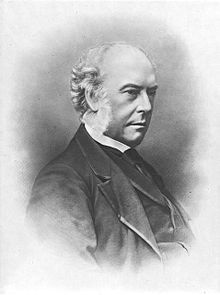
The first Cowper ministry was the second ministry of the Colony of New South Wales, and was led by Charles Cowper. It was the first of five occasions that Cowper was Leader of the Government. Cowper was elected in the first free elections for the New South Wales Legislative Assembly held in March 1856, and fought unsuccessfully with Stuart Donaldson to form Government. When Donaldson's Government faltered a little over two months after it was formed, Cowper formed Government.
The title of Premier was widely used to refer to the Leader of Government, but not enshrined in formal use until 1920. (Full article...) -
Image 14Location in Metropolitan Sydney
Canterbury-Bankstown Council, trading as the City of Canterbury Bankstown and stylised as CBCity, is a local government area in the Canterbury-Bankstown region of Sydney, New South Wales, Australia. The council was formed on 12 May 2016 from a merger of the City of Canterbury and the City of Bankstown, after a review of local government areas by the NSW Government.
The City of Canterbury Bankstown comprises an area of 110.8 square kilometres (42.8 sq mi) and as per the 2021 census, had a population of 371,006 making it the second most populous local government area in New South Wales. (Full article...) -
Image 15

Geoffrey Lee (born c. 1967) is a former Australian politician. He served as the Minister for Corrections in the second Perrottet ministry between December 2021 and March 2023. He has previously served as the Minister for Skills and Tertiary Education in the second Berejiklian and Perrottet ministries between April 2019 and December 2021. Lee was also a member of the New South Wales Legislative Assembly representing Parramatta for the Liberal Party since 2011 until his retirement in 2023. (Full article...)
Did you know (auto-generated)

- ... that Turkish international soccer player Rojin Polat was named member of the "2021 All Schools Merit Girls Team" in New South Wales, Australia?
- ... that many an Xplorer has traversed the rails in Canberra?
- ... that in its two years of existence, the Hunter River Railway Company initiated construction on what would eventually become the Great Northern Railway connecting Sydney to Queensland?
- ... that the rural village of Neath, New South Wales, had a population of three Tok Pisin speakers in 2021?
General images - load new batch
-
Image 2Hyde Park, Sydney with the Australian Museum under construction in the distance, 1842 (from History of New South Wales)
-
Image 7A chart of part of the interior of New South Wales by John Oxley, Surveyor General, 1822 (from History of New South Wales)
-
Image 8Olympic colours on the Sydney Harbour Bridge in the year 2000 (from History of New South Wales)
-
Image 9Ribbon ceremony to open the Sydney Harbour Bridge on 20 March 1932. Breaking protocol, the soon to be dismissed Premier Jack Lang cuts the ribbon while Governor Philip Game looks on. (from History of New South Wales)
-
Image 10Tumut 3 Power Station was constructed as part of the vast Snowy Mountains Scheme in New South Wales (1949–1974). Construction necessitated the expansion of Australia's immigration program. (from History of New South Wales)
-
Image 11The New South Wales Parliament is Australia's oldest parliament. (from History of New South Wales)
-
Image 12World leaders with Prime Minister John Howard in Sydney for the 2007 APEC conference (from History of New South Wales)
-
Image 13William Wentworth was key in the establishment of self-governance in New South Wales (from History of New South Wales)
-
Image 14Landing of Lieutenant James Cook at Botany Bay, 29 April 1770, by E. Phillips Fox (from History of New South Wales)
-
Image 15Founding of the settlement of Port Jackson at Botany Bay in New South Wales in 1788, by Thomas Gosse (from History of New South Wales)
-
Image 16Federation Pavilion, Centennial Park, Sydney, 1 January 1901. (from History of New South Wales)
-
Image 17Japanese POW camp at Cowra, shortly before the Cowra breakout (from History of New South Wales)
-
Image 18A bulk carrier entering the Port of Newcastle, New South Wales, 2009 (from Economy of New South Wales)
-
Image 20The 5th Governor of New South Wales, Lachlan Macquarie, was influential in establishing civil society in Australia (from History of New South Wales)
-
Image 21Dry paddocks in the Riverina region during the 2007 drought (from History of New South Wales)
-
Image 22A General Chart of New Holland including New South Wales & Botany Bay with The Adjacent Countries and New Discovered Lands, published in An Historical Narrative of the Discovery of New Holland and New South Wales, London, Fielding and Stockdale, November 1786 (from History of New South Wales)
-
Image 23Humanitarian Caroline Chisholm provided support to poverty-stricken women migrants (from History of New South Wales)
-
Image 25Mr E.H. Hargraves, The Gold Discoverer of Australia, returning the salute of the gold miners - Thomas Tyrwhitt Balcombe, 1851 (from History of New South Wales)
Topics
Categories
More portals
In the news
- 16 October 2024 –
- An explosion at a house in Newcastle upon Tyne, England, kills at least two people and injures six others. An investigation to determine the cause of the explosion by the Health and Safety Executive is underway. (BBC News)
Associated Wikimedia
The following Wikimedia Foundation sister projects provide more on this subject:
-
Commons
Free media repository -
Wikibooks
Free textbooks and manuals -
Wikidata
Free knowledge base -
Wikinews
Free-content news -
Wikiquote
Collection of quotations -
Wikisource
Free-content library -
Wikiversity
Free learning tools -
Wikivoyage
Free travel guide -
Wiktionary
Dictionary and thesaurus




